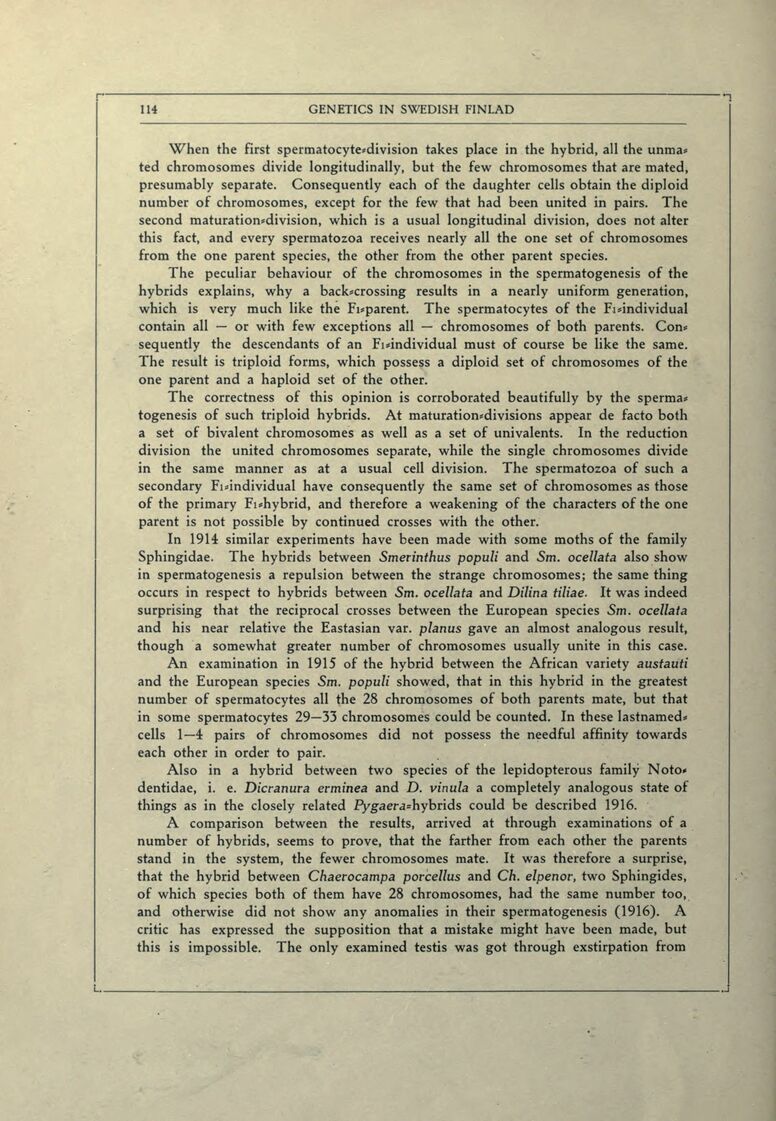
Full resolution (JPEG) - On this page / på denna sida - Part I - Docent Harry Federley, Helsingfors, Genetics in Swedish Finland

<< prev. page << föreg. sida << >> nästa sida >> next page >>
Below is the raw OCR text
from the above scanned image.
Do you see an error? Proofread the page now!
Här nedan syns maskintolkade texten från faksimilbilden ovan.
Ser du något fel? Korrekturläs sidan nu!
This page has never been proofread. / Denna sida har aldrig korrekturlästs.
When the First spermatocyte»division takes place in the hybrid, all the unma«
ted chromosomes divide longitudinally, but the few chromosomes that are mated,
presumably separate. Consequently each of the daughter cells obtain the diploid
number of chromosomes, except for the few that had been united in pairs. The
second maturation«division, which is a usual longitudinal division, does not alter
this faet, and every spermatozoa receives nearly all the one set of chromosomes
from the one parent species, the other from the other parent species.
The peculiar behaviour of the chromosomes in the spermatogenesis of the
hybrids explains, why a back«crossing results in a nearly uniform generation,
which is very mueh like the Fi»parent. The spermatocytes of the Fi«individual
contain all — or with few exceptions all — chromosomes of both parents. Con«
sequently the descendants of an Fuindividual must of course be like the same.
The result is triploid forms, which possess a diploid set of chromosomes of the
one parent and a haploid set of the other.
The correctness of this opinion is corroborated beautifully by the sperma«
togenesis of such triploid hybrids. At maturation«divisions appear de facto both
a set of bivalent chromosomes as well as a set of univalents. In the reduction
division the united chromosomes separate, while the single chromosomes divide
in the same manner as at a usual cell division. The spermatozoa of such a
secondary Fi«individual have consequently the same set of chromosomes as those
of the primary Fi«hybrid, and therefore a weakening of the characters of the one
parent is not possible by continued crosses with the other.
In 1914 similar experiments have been made with some moths of the family
Sphingidae. The hybrids between Smerinthus populi and Sm. ocellata also show
in spermatogenesis a repulsion between the strange chromosomes; the same thing
occurs in respect to hybrids between Sm. ocellata and Dilina tiliae. It was indeed
surprising that the reciprocal crosses between the European species Sm. ocellata
and his near relative the Eastasian var. pianus gave an almost analogous result,
though a somewhat greater number of chromosomes usually unite in this case.
An examination in 1915 of the hybrid between the African variety austauti
and the European species Sm. populi showed, that in this hybrid in the greatest
number of spermatocytes all the 28 chromosomes of both parents mate, but that
in some spermatocytes 29—33 chromosomes could be counted. In these lastnamed«
cells 1—4 pairs of chromosomes did not possess the needful affinity towards
each other in order to pair.
Also in a hybrid between two species of the lepidopterous family Noto»
dentidae, i. e. Dicranura erminea and D. vinula a completely analogous State of
things as in the closely related Pygaera«hybrids could be described 1916.
A comparison between the results, arrived at through examinations of a
number of hybrids, seems to prove, that the farther from each other the parents
stand in the system, the fewer chromosomes mate. It was therefore a surprise,
that the hybrid between Chaerocampa porcellus and Ch. elpenor, two Sphingides,
of which species both of them have 28 chromosomes, had the same number too,
and otherwise did not show any anomalies in their spermatogenesis (1916). A
critic has expressed the supposition that a mistake might have been made, but
this is impossible. The only examined testis was got through exstirpation from
L.
<< prev. page << föreg. sida << >> nästa sida >> next page >>